A personal learning blog about my two favorite subjects: detective fiction and game studies
Don't wanna be here? Send us removal request.
Text
Essay #14: Trails series – Worldbuilding of The Now
<Link to Essay #14>
0 notes
Text
Essay #13: Slow Play
<Link to Essay #13>
0 notes
Text
Essay #12: A Short Walk Through New Vegas’ Wasteland
<Link to Essay #12>
0 notes
Text
Essay #11: Introspective Roleplaying: CRPGs as Reflective Playgrounds
<Link to Essay 11>
0 notes
Text
Play #10: The Irreconciliation between Player and Avatar in CRPGs
While most CRPGs often feature undefined protagonist as a vessel for players to inject themselves into, the reality is that there is an impossible irreconciliation between the player’s immersion and the character’s live-in state. It is an obvious statement, yeah, but I have never thought deeply about its strange relation in narrative-driven games until now.
To begin with, for a player to enter the magic circle of CRPG, there is an implicit agreement that they have to suspend their disbelief by believing that such a virtual avatar can be a representation of them. On a basic level, the suspension of disbelief is needed for the narrative to work. After all, if the player is constantly aware that they are playing a game, they would also realize the truth that they have no real personal stake with the world itself. Whether or not the game world is destroyed, it does not directly impact their real life, or at least, not on the same level as with predefined protagonists. The player is inherently separated from the game world no matter how much they are invested in it: they have no background tie to the game world, and their vessel is often a character who only pops into existence the moment the game begins. As such, the suspension of disbelief is necessary for the enjoyment of a fictional narrative whose leading character is an empty vessel. Otherwise, how can the player have a meaningful narrative moment in the story if they are constantly aware that everything is fictional?

One of the strategies a player can employ in order to get past that irreconciliation is to go along with the genre’s definition: roleplaying. Through roleplaying, the player can disregard their real world’s self to take on an alternate persona who is supposed to live in the game’s setting. In short, they can treat the undefined protagonist as a semidefined protagonist and control them based on their ideas of an alternate self. The player here enters a limbo state between fiction and reality: they are still aware that the game is simply a fictional space, but their character will perceive the game’s world as an actual living world. In a way, through roleplaying, the player can get rid of the constant nagging of the video game’s limitation, and instead, they can treat the game’s narrative as one that closely resembles the linear narrative found in popular mediums such as books or films. Hence, it’s why roleplaying is often seen as an opposite of minmaxing, which draws more attention to the game system.
Story-driven CRPGs that invite the player’s real-world persona are fairly rare. While many games may seem to use the word “You” to refer to the player’s actual self, more often than not the word refers to the avatar vessel, who may not need to be the player themselves. I haven’t encountered a CRPG that directly refers to the player’s actual persona in a way that the player can’t delegate that reference to their alternate self. On the other hand, such technique has been done in other game genres. Like other mediums, there are plenty of metaphysical narratives in video games that use such direct connection for effective narrative moments such as in Doki Doki Literature Club, Undertale, or Paper, Please.
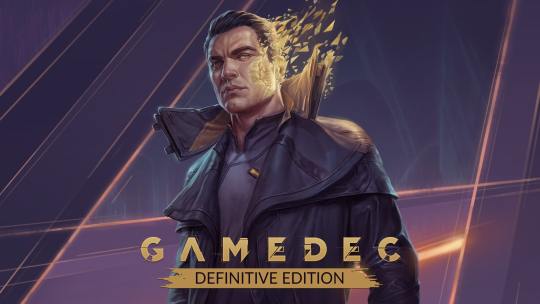
Why then is the CRPG genre reluctant to refer to the player directly even though it is a genre whose biggest appeal is that the player's decisions can shape the story? Is it because CRPGs are often so adherent to the classic epic adventure’s narrative structure that they can’t take into account the player, who is an anti-fictional being? After all, can a fantasy adventure still be suspenseful if the player lacks a suspension of disbelief? How can a fictional character’s yearning for their life matter when the player is always conscious that these characters are just codes written to deliver a story?
Perhaps the more interesting question here is, what sort of interesting narratives can such hypothetical CRPGs deliver if handled well? Much as I want to end this post with a hypothetical model of said concept, I unfortunately lack the imagination right now to come up with one. Maybe such a CRPG has already existed, but I haven’t found it yet in the sea of games.
0 notes
Text
Essay #10: Layers of Magic Circle: the Intended Design and the Player’s Design
<Link to Essay 10>
0 notes
Text
Note #44: Walter S. Masterman’s The Wrong Letter: The blind spot
(This post contains full spoilers of the novel)

The detective figure and the assistant dynamic have always been an integral part of the classical formula. It was there since Poe’s The Murders in the Rue Morgue, and Arthur Conan Doyle only further popularized the dynamic with Sherlock Holmes and Doctor Watson. At some point, the dynamic has been so widespread among classical detective stories that not having them is like a romance novel not featuring romance. In their most basic roles, the duo often act as the reader’s gateway into the fictional world: they are the ones that gather the clues for the readers to theorize, and who also provide additional hints about the solution should the reader need guidance. With such important recurring roles, they tend to be the safe bets for being innocent when the reader tries to narrow down the identity of the culprit. Yet, such an assumption makes the duo a perfect blind spot in readers’ eyes, which some writers have used to full extent for a twist such as in Walter S. Masterman’s The Wrong Letter novel.
Like many works that were published around the peak of the Golden Age of Detective Fiction, The Wrong Letter also begins with an introduction of the detective and his assistant, along with a typical whodunit mystery: Superintendent Sinclair is sitting in his office when he receives a strange call from an unknown person who claims that the Home Secretary is going to get killed. Just as Sinclair is pondering over the news, arriving in his room is Collins, a sleuth who has been working with Sincliar from time to time. The two soon depart to the Home Secretary’s house to discover the truth. The first chapter pretty much sets up the typical dynamic of the detective duo: Collins the eccentric detective and Sinclair the layman.
In keeping up with tradition, the primary point of view of the novel is through Collins’ point of view as he investigates the crime: He is the first person that investigates the crime scene, and he is also the one that conducts most of the questioning with the person of interest. Along the investigation, Collins also trades theories with his partner Sinclair. Like a good assistant who is supposed to be an audience surrogate, the nervous superintendent often acts clueless and questions the detective’s bizarre theories. In treating these two as close to their classic archetype, the novel attempts to render them as an innocuous factor: they are entertaining, but not the point of focus of the novel—the main draw here is the mystery behind Home Secretary’s mysterious death in the locked room space instead.
But that’s all a facade Masterman puts on for the reader. Chesterton was right when he wrote in the Preface that he “will confine [him]self strictly to saying what [the author] does not do”, because the real trick of the novel lies precisely in a disruption of the trope: the assistant is actually the detective, and the detective is actually the culprit.
Masterman achieves this trick through the use of an unreliable narrator and reader’s familiarity with the formula. From the beginning, Sinclair is often portrayed as a clumsy assistant who is dependent on the detective. Sinclair’s negative traits are put on upfront such as when he helps himself to the victim's whisky in chapter I: "It was a little weakness he had". Likewise, for most of the novels, he serves as audience surrogate by listening attentively to Collins’ theory or by lacking a capacity to interpret clues by himself. Everything seems to point as him being just a layman who is competent for his job, but not on par with the mar. In a way, the novel encourages the reader to not expect much from Sinclair, so when it is revealed that Sinclair is actually a careful detective who tries to avoid too many hints to his suspect, Collins, it recontextualizes his whole caution and shyness as not being clueless, but as an attempt to draw clues from Collins. In particular, the scene in Chapter XX where Sinclair ponders over Watson’s letter takes on a special meaning under this contextualization. Instead of being just a scene where the assistant cluelessly withholds a vital clue from the detective for a later dramatic effect where a strange clue finally fits into the whole puzzle, the truth is that Sinclair is perfectly capable of interpret that clue by himself, and that letter is what transforms him into a full-fleshed detective that the audience doesn’t get pried into.
“I would like to see inside your head, and find out what there is there,” said Sinclair. “You’ve something concealed.” — Chapter XIV
The novel also attempts to hide Collins’ true identity in a similar manner, but in an opposite direction. Whereas Sinclair’s characterization is hidden underneath all the outward depictions of uncertainty and incompetency as per assistant tradition, Collins’ is revered in absolute authority. Throughout the novel, Collins often makes absolute statements about the case that do not seem suspicious at first glance precisely because they are in line with the norm of the genre. An example of this is in chapter IX, where he calls out the idea of John Jackson, a lunatic, being the culprit as “absolute rubbish”. To a familiar audience, the line seems innocuous—being the detective figure, Collins is probably right that we might get the wrong person—but the double meaning lies in his hidden motive: Collins wants to hinder the investigation’s process as much as possible so that he could find his target, Sir Ronald Watson, under the pretense of needing him for the investigation. This trick repeats multiple times throughout the novel: every time Collins acts like his supposed trope, the detective, it is because he wants to avoid drawing suspicion to himself as he advances his own personal plan. Even his thought process, which the reader does get pried into, is often vague enough to hide his real motivation of trying to find the victim’s estranged son. By hiding in plain sight, Collins’ true identity as culprit manages to stay in the reader’s blindspot.
Collins laughed. “That’s just what I was thinking. What are you after? Well, we will each keep his own counsel.” — Chapter XIV
This archetype subversion twist calls into question the audience's overreliance on familiar tropes. By making Collins the culprit and Sinclair the detective, the novel calls into question the kind of bias the reader may have about their unquestioned trust in the archetypes, especially when it comes to lead characters. For a genre that thrills on using rationality to discover the truth, such bias is dangerous, and the novel demonstrates such impact by making the culprit the one person that the audience thought they could trust unquestionably. In that sense too, the trick serves as a reminder that the reader should think for themselves, instead of relying on a character’s point of view as their objective view.
While the ending does feel like it ends too abruptly with Collins getting his just dessert off-screen, The Wrong Letter was a pleasant read overall. The trick of subverting detective and assistant’s dynamic is not exactly that rare nowadays, but it is always fun to encounter and get fooled by it. It would be fun to write a long essay on this subject eventually.
0 notes
Text
Play #9: Talisman’s emergent narrative: making meaning out of chance
A few weeks ago, I played Talisman: Digital Edition with my friends. As its name suggests, the game is a digital adaption of Games Workshop’s classic board game from 1983, Talisman. The game’s main objective has players taking turns rolling dice to travel around the gameboard, fighting enemies and collecting loot before they can venture into inner zones to become the winner. Indeed, if that description hasn’t reminded you of a typical RPG’s gameplay loop yet, then the fact that the game’s aesthetic theme is western fantasy should cement that. That being said, the board game is definitely not meant to be a storytelling-focused game like Dixit or the typical Tabletop RPG; none of Talisman’s rules mentions nor encourages players to tell a story as they play along. Yet nevertheless, the emergent narrative formed unintentionally through our playing was what made the game really fun for us.
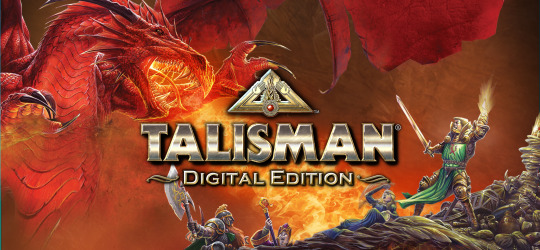
This emergent narrative caught my attention when after we finished our first session, one of my friends said that the campaign was fun and then proceeded to describe the experience in fantasy narrative style. To call our session a “campaign” reminded me of Dungeons & Dragons (my friend knows a little bit about DnD), and when I looked back to our playing session, our Talisman session did feel similar to a fantasy adventure: we worked together to take down the Sentinel, we kept losing our healths inside the harder areas, we made fun of each other when our lucks weren’t in our favor, and so on. The game was already fun to play as it was, but by describing the session in terms of DnD style, we also produced a fun story too. For example, this was our most favorite moment in our first session:
Reality: I accidentally lost my last Life Point by not paying attention. Unexpectedly, that death gave me a chance to turn the game around. When I got revived, I got lucky and drew a spell that lets me steal a powerful item from my friend. This one singular decision ended up having a big ramification to the point of leading me to victory.
Narrative: The Exorcist visited the graveyard to make a pact with the Devil. In exchange for his life, he gained immense power that let him steal a powerful artifact from his ally—a wand that lets him cast numerous spells. With this newfound power, obtaining the Crown of Command was an easy task for him.
Notably though, the way we created narrative here was slightly different from roleplaying: instead of acting in alternate persona in order to form a narrative, here, the narrative was formed retrospectively. None of us played the game with the intention to tell a story, and yet we nonetheless looked forward to the kind of absurd narrative that could be generated from our playing.
One specific feature of Talisman that contributes the most to the creation of this emergent narrative is the matter of “fortune”, a central point of playing according to Sarah Lynne Bowman. While Talisman has been met with criticism before for being too luck-based, I think half the fun of the game is dealing with bad luck. The unpredictableness of dice rolls opens up opportunities for us to laugh at each other’s misfortunes or to get surprised by an unexpected turn of event. Granted this randomness might not be fun for everyone, but for my friend group, who loves “stories so absurd it is fun” (it’s the reason we watch Riverdale weekly), Talisman is perfect for us! Even boring moments can be translated into something memorable, such as with our second run. New to the game, we were unaware of the Firelands Expansion’s difficulty, so our combination of the expansion with a specific victory condition that did not gel well ended up making the run horrible. To put it plainly, we had to end the run prematurely because it was miserable to keep playing when everyone just died every turn due to fire tiles. As a story, however, it was frankly entertaining to look back on: just a bunch of heroes who failed to save the world from hellfire, so they slowly burned in hell for their damnation sins. This sort of emergent narrative, which is resulted from unpredictable dice rolls and our interpretation of events, demonstrates the power of narrating: it can turn individual gameplay moments into a meaningful sequence.
Overall, I find it interesting that this emergent narrative is “forcefully” constructed by the players instead of being a natural part of the game’s convention. In a way, such a narrative making process can serve as an example of how players' experience doesn’t necessarily have to correlate to a game’s intended design in order for them to have fun.
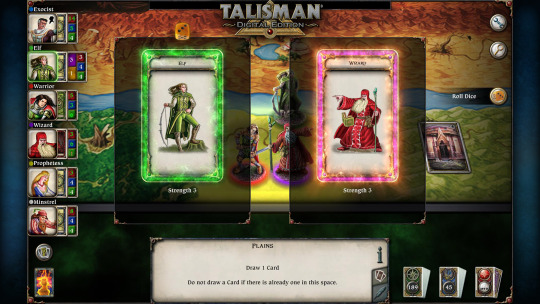
P/S: I wonder what it would be like to play Talisman as a roleplaying game?
0 notes
Text
Essay #9: The Blasphemy and The Triumph in Dismantling Video Game’s Sacred Circle
<Link to Essay #9>
0 notes
Text
Play #8: Beating for the sake of beating?
One of the things I’ve come to appreciate lately is the joy of beating the game for the sake of it. I used to believe that to enjoy a game to its fullest, I have to experience as much content as I can: all of its side quests, all of the optional minigames, all of the secrets, and so on. The thought of skipping these contents rarely crosses my mind, in part because I thought I would have a lesser experience; after all, doesn't the journey through the game matter more than the destination? Yet, such obsession with “full experience” was perhaps one of the reasons I soured my experience with some games by forcing myself to slog through parts I didn’t like. Thankfully, I’ve gotten better at understanding why I enjoy playing video games, so I’ve left that mentality in the past. Sometimes it is nice to just prioritize my own enjoyment over experiencing everything; that’s what I did with Legends of Amberland, Victor Vran, and Trine series, and what made me love these games a lot, enough that I want to replay them properly one day. Had I forced myself to experience everything in these games (in particular with Trine’s late-game difficult puzzles), I knew I would have gotten burned out sooner or later.
This priority reminds me of how I used to play with toys back in childhood. Here, I optimize my own enjoyment first and foremost, while disregarding the game’s intact cultural or artistic value. My goal is to relax through engaging with the game’s content: to puzzle out the solutions, to laugh at the humorous writing, to enjoy an epic story mindlessly, to have fun overcoming a combat challenge, and so on! And once I begin to feel bored with the game, I just rush into the ending instead of forcing myself to play further. If I am playing simply to entertain myself, not to evaluate how well-crafted the game is, there is nothing wrong with not experiencing all the contents so long as I feel entertained the whole playthrough, isn’t it? The key lesson is that I should not feel guilty for not experiencing everything fully; there is always next time.

Still, why do I need to beat a game first in order to consider my whole playthrough to be fun, I wonder? There are times when a lack of proper conclusion often leaves me feeling empty, but I never thought hard about why a conclusion is important to my enjoyment. For example, while I do enjoy playing open-ended life-sim games like Animal Crossing: New Horizons or Stardew Valley, I usually get bored eventually, which in turn sours my feeling toward them even if I had fun playing them before that. I feel the same struggle with roguelike games despite my liking of their gameplay. In a way, the only way I could feel satisfied from playing these games is to establish an end goal—something to stop my engagement before boredom takes over. Take Dead Cells for example, I set my end goal to be beating the seventh level Astrolab, so when I reached it, I was left satisfied and had not touched the game since.
Additionally, there were times when I could feel this same satisfaction even though I "finished" a game through an alternate means instead, such as through watching a YouTube video. This was the case with Utawarerumono: Mask of Truth. As the final battle was too difficult for me, I had to resort to a YouTube video to see the ending. Similarly, I couldn’t finish Yakuza 0 in game because the game constantly froze at the final boss cutscene on my old lap, so watching the ending online was my only option to conclude “my” playthrough. Even though I didn’t “earn” such an ending, I still felt a similar sense of accomplishment, or joy, that came from beating a game. What is this satisfaction that comes from beating the game? Could the answer be as simple as because finishing a task is fun?
What’s more, I’m also curious if my urge to reach the end of a game at all cost is inherent to my mind, or if it is learned as a consequence of consumerism. By consumerism, I referred to the behavior of hoarding games that has been normalized in gaming culture. Everywhere I go on the internet, jokes about the endless backlog are everywhere; it’s fairly common for someone to take pride in cleaning their backlog (including me), as though video game is something to get through, not to experience. Putting it that way, I can’t deny the possibility that one reason I enjoy rushing to finish a game is because I want to clear my backlog: to put the game out of my mind so I can focus on something else. Even so, the reality here is that I only love the Trine series as much as I do right now precisely because I rushed to the end instead of forcing myself to play the parts I didn’t like. Perhaps it is unwise to conclude that the urge to rush to the ends should be unlearned simply because it can be associated with consumerist mentality.

Lots of questions opening up with little answers… I will have to revisit this topic another time.
0 notes
Text
Play #7: Let’s Play as an adaptation?
Back in Play #4, I mentioned the idea of watching YouTube’s Let’s Play as a curated linear experience, but I didn’t think much yet about the value of the commenter. It’s not because I dislike commentor or something, but because I thought they would distract me from getting absorbed into the game. Upon watching the Let’s Play series of Siren (by supergreatfriend) and Mizzurna Falls (by iconoclast187), not only have I come to appreciate the value of well-informed commentary, but doing so also gives me a few thoughts on the peculiarity of translating video game’s interactivity into linear format.
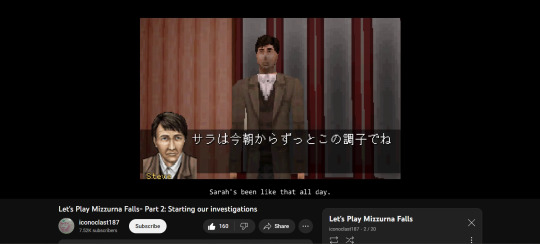
Part of the reasons I chose to watch Siren and Mizzurna Falls over playing them by myself was because these games are notorious for their difficulty. For Siren, the difficulty comes from the amount of bizarre hidden objectives and strict stealth missions. Meanwhile, solving the mystery in Mizzurna Falls requires players to know exactly where and when each event will occur if they want to get there in time to gather clues. In a sense, these difficulties encourage players to slowly figure things out across multiple playthroughs, but for someone who is not into that kind of game design, watching Let's Play was a better choice for me. At first, I planned to watch a no commentary or a blind playthrough, but out of curiosity I figured why not watch a playthrough by a skilled player instead? Turned out, that was an amazing decision.
What I’m most impressed about the commentary in these videos is that it walks a fine balance in pointing out obscure mechanics or story details that most players will miss, but not overdoing it to the point of ruining viewer’s surprise. For example, because both games can be dense to follow with their multiple plotlines going on, both commentators often explain various minor connections between characters, but they never deliberately give away direct answers to the mystery. Unlike a blind playthrough whose appeal is the commentator's reaction then, these Let’s Play videos focus more on showcasing the in and out of the game; the commentators act more like a tour guide to the viewers. This comparison applies the most to Siren's case: supergreatfriend often mentions various external media around the game, such as the game’s official website and its sequels, to give the audience an overview of the series’ history. Honestly, I don’t think I would appreciate these games as much if I played by myself; I wouldn’t notice all the fine details in these games, nor do I have the skills to enjoy their gameplay.

Such struggle also makes me realize that engaging with video games requires more skills from consumers than other mediums such as books or movies. For someone who has played video games since childhood, playing games has become a second nature to me, but for many people, it is definitely not. Razbuten’s What Games Are Like For Someone Who Doesn't Play Games video, for example, really shows the amount of skills required to properly engage with a video game. In the same way that such skill requirement is important to some video game’s identity such as Dark Soul, that difficulty can inadvertently alienate a lot of people from truly appreciating video games also. Watching a Let’s Play, especially ones accompanied by well-informed commentary, can allow viewers to appreciate the art of video game design even if they themselves don’t have the necessary skill to play it by themselves. Nothing can replace the experience of playing the game by yourself, of course, but Let’s Play does offer an alternative experience, one that, I think, bears resemblance to experiencing a work through an adaptation.
In a way, watching a Let’s Play video reminds me of watching a TV adaption of a book. The comparison is odd, indeed, but I do think there are some merits to it. At the end of the day, most Let’s Play videos are not pure, unedited footage; they were recorded, cut, and edited into a specifically curated experience first before they get published online. The videos thus remain containing elements of the original work (the gameplay footage), but also offer a new experience in mind (such as entertainment). For example, turning Siren and Mizzurna Falls into a linear video format does rob their interactive gameplay away, but in exchange, the commentary accompanying these Let’s Play series do teach the viewer about the game series’ artistic values in a way that playing the game by myself does not. To put it another way, Let’s Play series is half-original, half-not.
I suppose the biggest question I want to raise in this post is this: how are these “adaptations” different from common adaptations like movie or TV Show adaptations, outside of the biggest difference being that Let’s Play videos are made by hobbyists? Of course, these kinds of “adaptations” created by hobbyists do not undergo the review processes nor have that “professional feel” that official adaptations would have. Likewise, if I go by Oxford Reference’s definition of adaptation—”the process of making a work of art upon the basis of elements provided by an earlier work in a different, usually literary, medium”—then most Let’s Play videos probably won’t fit since they lean more toward entertaining and/or educational (documentary, perhaps?). Nevertheless, there is no denying that a lot of thoughts, and artistic sense even, get put into the process of turning raw gameplay footage into accessible videos, not to mention making commentary is an art in itself. Furthermore, it is significant that this presentation style has a strong public demand too. Despite being able to play the games by themselves, many people willingly choose to watch a Let’s Play instead precisely because they prefer that kind of experience; this was what I did with Spirit Hunter: NG. I wonder if the bigger question I have here is that what if watching Let’s Play is not an inferior experience compared to playing, but an equally alternative experience in itself? Isn't this sort of experience the reason people are drawn to adaptation?
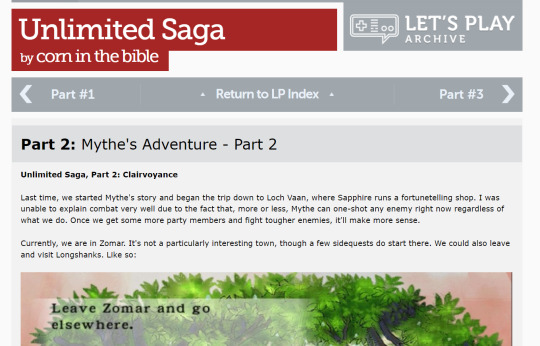
P/S: The most surprising thing about Let’s Play for me is that before the video format even became popular, text Let’s Play was already been a thing; Let’s Play Archive features a gigantic collection of these Let’s Play if you want to check it out. The act of translating a visual medium into a text medium with numerous screenshots is so fascinating. Not only do the commentators have to adapt a lot of visual and audio features into text format (such as dialogue boxes), but they also have to be selective about chosen screenshots; no one likes “reading” a wall of endless screenshots. It sure takes a lot of skills to make Let's Play, whether in text or in video.
0 notes
Text
Essay #8: CRPGs and the Self: An Introduction to Introspective Roleplaying
Usually, I avoid writing long essay back to back in order to give myself sometimes to think, but finishing Dragon Age: Inquisition last weekend motivated me to work on this essay, which deals with the idea of using solo roleplaying to do introspection. It is built upon the concept of playing for one's own sake that I discussed in Essay #7 as well as my own experience with roleplaying in CRPGs. In a way, this essay also serves as an comprehensive piece about my current understanding of roleplaying's values, or more specifically solo roleplaying's.
Since I'm planning to write more about introspective roleplaying, new to this blog is the tag #tmc_roleplaying. I look forward to turning CRPG genre into something special for myself!
<Link to Essay #8>
0 notes
Text
Essay #7: Experiencing for Self & Experiencing for Others
My latest essay about the idea of experiencing for my own sake versus experiencing for others’ sake is up. It feels really nice finally working out why I enjoy fiction so much as well as coming up with new studying plan. I can say for sure that if I follow my new experiencing motivations listed in the essay, I won't ever experience a huge burnout from fiction ever again.
As usual, I will take a break next week to work through my reading backlog, mostly essay collections. I think I already have a good idea of what to write next, but it wouldn't hurt to do a little bit more research.
<Link to Essay #7>
#tracingtheculpritstrack#tracingthemagiccircle#tmc_engaging#tmc_essay#tct_personal#tct_essay#tracinginward_essays
0 notes
Text
Play #6: The Magic Circle of Just Dance
I know in my latest essay I said that I would stop talking about “Stupid Media” for the time being, but my recent renewed obsession with Just Dance makes me think it would be a fun to talk about the silliness of playing a dancing video game; nice change from all that talk about video game narrative lately.

Most people have probably heard about Just Dance, Ubisoft’s dancing video game series that is famously known for its continuous release on the Wii even when Wii U and Nintendo Switch already made Wii obsolete; Just Dance 2020 in particular was the final Wii game that was released physically in North America. Its gameplay is as simple as it gets: the player dances to the choreography on screen, earning points by performing the correct moves. The song list is generally made up of a mixture of classic songs as well as modern ones, and aesthetic-wise, the game’s choreography videos are very colorful and energetic. It is a fairly simple formula, but it works well enough that the series has continued releasing new entries yearly. Due to its casual nature, I am not surprised that conversation about the series rarely occurs in gaming discussion; I suppose that as the game gets released yearly with the same old formula and all, not much more can be said about the series’ evolution in gaming design (outside of upgraded visuals and more complex dancing moves). But despite all of that repetitiveness, Just Dance continues to be a fun part of my life for nearly a decade now, and so I think it would be fun to examine why it is fun to me. The simplest answer is that it is just fun to dance to colorful music videos! But after some thinking, I think there are a few more reasons to that, which I can chart it up to the power of playing inside a magic circle.
One of the ideas that comes to my mind right now is Theorizing Stupid Media’s concept of bodily stupid. In the chapter “The Stupid as Ludonarrative Dissonance”, the book mentions that one of Pokemon GO’s appeal might be explained by the way it forces players to move their body weirdly: “One of the things that Pokémon GO illustrates is that the stupid is not singularly located in the media referent, but rather in the reception of the body. The way that we respond to watching other bodies (mindlessly) twist, tumble, fall, relent to gravity, or confront the concrete realities of space, geography, architecture”. But more importantly, such bodily stupid often evokes a desirable reaction: “it is the uncontrolled flailing body in a Pokémon GO fail that elicits a different affective response—laughter”. Such laughter, I think, is one of the reasons I’m drawn to Just Dance to this day.
As much as I love Just Dance, I have to admit that most of the choreographies are not designed to elicit a sense of professional dancing, at least not the kind of acceptable forms of public dancing like salsa, ballroom, and hip hop, in part because of the series’ casual vibe. As the series is supposed to appeal to all ages, the choreographies in general are often repetitive and simplistic. Back when Harmonix's Dance Central was still a thing, people often compared its complex dance choreographies to Just Dance’s as a way to make fun of the latter’s simplicity. Nevertheless, the series’ casualness is also what makes it perfect to play at a party! I still remember how these games were often a blast at my parties; there were laughter from my friends who flailed around, trying to match up to the choreography, as well as from those who just had fun watching the players fumble badly. Those joys occurred through the bodily stupid produced by the game. In a way, even though we laughed at each other’s clumsy movements, it was not with the intention of making fun of them, but more so in the shared joy of playing. I wonder if this is a similar principle behind party games that involve body movement like Twister?
In a way, Just Dance’s great strength is its casual approach to dancing, from its vibrant visuals to ease of use. Even people who are unfamiliar with gaming can easily play the game by themselves; all they need to know is how to open the game, select a song, and dance to it. Moreover, no matter how badly the player performs, the game’s positive vibe doesn’t berate them for failing, but encourages them to try again. In game studies terms, I could say that the playful atmosphere of the series forms a magic circle for people to dance to their heart's content without being made fun of; a safe space to explore the joy in dancing even if you are not good at it (me!). It is funny to compare dancing to Just Dance to the idea of live-action role playing (larp for short), but I think Stenros and MacDonald’s quote that describes the joy of larping also applies to playing Just Dance: “They are beautiful to do, but not necessarily interesting to watch”. Yeah, I may fail to dance well, but it is the attempt to dance to my heart’s content that makes Just Dance fun for me! It is this kind of joy that makes me return to the series, solo or with friends, for nearly a decade now.
Thinking about Just Dance as a magic circle also gives me some thoughts about the values of the circle itself. After all, Just Dance is the kind of game that technically can work even without the medium; one can simply play a YouTube video of the game and dance to it. But such imitating typically lacks the value of immersing into the magic circle and respecting the game’s rules. By following the game’s immersion rule—I have to move my entire body even if the game only tracks my hand movement through “larping” tools such as a joy-con or my phone—I enter into a safe space that allows me to dance badly without getting made fun of. I suppose, the value of playing inside a magic circle is that it allows one to safely explore a concept that is outside of their comfort zone without getting berated. Without a magic circle, playing is simply imitating, an act that is often frowned upon in societal rule. There is still a lot more to look into about the powers of dancing and the rules of magic circle, but I will stop this essay for now. I can say for sure that I don’t see myself losing my love toward Just Dance series any sooner (well, maybe if they increase Just Dance Now’s subscription costs…)

P/S: Stefanie Heinzmann’s Diggin' In The Dirt is such a great motivational song to dance to every time I ever feel down.
0 notes
Text
Essay #6: Choose Your Own Stupid Adventure, Make Your Own Meaningful Fun
My new essay is finally up! It has been really fun rethinking about my engagement with nonlinear RPGs' narrative systems. Looking forward to see how I can further expand all of these ideas in the future.
For now, I will take a break next week to read more essays about video games and detective fiction. I haven't read anything lately.
<Link to Essay #6>
0 notes
Text
No short post this week!
I'm working on a long essay for Tracing the Magic Circle tab right now. My plan is to post it later this week or early next week at the latest.
EDIT: Unfortunately, I got really busy over the weekends so it's unlikely that I can finish the essay by tomorrow. That being said, it should be ready by Friday!
0 notes
Text
Note #43: Perry Mason’s The Case of the Lucky Legs: Battle over the authoritative narrative
(This post contain full spoilers of the novel)
I just finished Perry Mason’s The Case of the Lucky Legs recently, and it has been a fun read! Overall, the culprit, Bradbury, is fairly easy to guess early on just by examining meta-clues. For one, he is a 50-years-old “sugar daddy” who wants to help a young, beautiful girl half his age because he is in love with her; that alone is discriminatory enough. And two, in one of the early scenes, he forgets to bring a crucial evidence to Mason. In a clue-puzzle story where the implicit rules often forbid coincidence or chance from having a place in mystery, the fact that a character forgets about something is significant, which proves to be true when Bradbury’s forgetful moment becomes one of the clues Mason uses to prove that Bradbury is the culprit. Nevertheless, for being an easy culprit to figure out, he makes for a formidable opponent against Mason with his cunning capacity to establish narrative on the go.
In detective fiction, detective figures’ most distinct role is that they are often the only character that can theorize the true narrative of the crime: who committed it, why it happened, and how it unfolded. Generally, this process of discovery tends to operate under the assumption that the crime’s true narrative is usually left untouched by the culprit, only waiting to be discovered. However, this is not the case in Lucky Legs. Throughout the course of the novel, just as Mason is trying to discover the real narrative behind the death of Frank Patton, Bradbury is also trying to create a new falsified narrative by making additional false clues post-crime to hide his involvement. This active involvement is hinted at by how often Bradbury refers to himself as “a fighter”: he is not a passive culprit who is just waiting for the detective to find him; he can fight back. Thus, not only does Mason have to follow the traditional detective role in discovering the true narrative of the crime, but he also has to fight against Bradbury’s ongoing narrative in the present as well. What is usually a one-sided conflict turns into a duel where both of them are trying to establish their own narratives while feeding each other false clues.
This kind of conflict also leads to a change in the typical revelation scene of a detective story where the detective reveals the truth to a third party. Instead of having Mason spill out the revelation in an explanatory manner to the third party consisting of Riker, Johnson, and Detective Sergeant O'Malley, Chapter XVIII forces Perry Mason to have a final confrontation with Bradbury where he has to prove his version of the narrative is more credible than Bradbury’s version. As someone who enjoys reading debates between characters, this chapter makes for a fun read! In the end, the confrontation between the two fighters is resolved not with an action-packed chase scene, but with simply a logical trap that Mason lays for Bradbury: “I warned you, Bradbury, … not to lie about that telephone call to Marjorie Clune. I told you that it would be a confession of guilt" (Chapter XVIII). Where Bradbury fails, however, is that he is not a storyteller, only a bad bluffer. Once Bradbury is unable to dig out of his own lies, his falsified narrative falls apart and the victory is handed to Mason, who manages to provide a consistent narrative. As Mason says to counter Bradbury’s recurring imagery: “I, too, am a fighter”; the detective figure is capable of not just discovering true narrative, but also resisting against false narrative. To put it in another way, the process of discovering the truth requires the detective figure to prove the credibility of his interpretation AND defend it from other interpretations.
Hmmm, I wonder how to dig deeper into this idea of battling for authoritative narrative… I do find it interesting that the presence of the third party is vital for the revelation scene, not just in this novel but also in detective fiction in general. Is the concept of getting recognized in public or by a neutral party that makes a narrative authoritative? What could have happened if Mason perished before he could tell the truth? Would Bradbury’s full-of-hole narrative take over as authoritative because he is the only one left to tell the truth, something along the line “dead man tells no tale”? What is the bigger idea at stake here? If I want to look deeper, I think I should reread Danganronpa, a series that is well known for taking this debate idea to an extreme.
0 notes